

The artist's choices of drawing media — tools and surface — tend to determine whether a drawing will be more or less linear or painterly in quality.
There are many sorts of drawing techniques, varying according to the effect the artist wants, and depending on whether the drawing is an end in itself — an independent and finished work of art -- or a preliminary to some other medium or form — although distinct from the final product, such drawings also have intrinsic artistic value. Preliminary drawings include various exercises (e.g., contour drawing, gesture drawing, figure drawing, drawing from the flat), as well as sketches and studies, cartoons and underdrawings.
Drawing has been highly appreciated since the Renaissance, greatly because it implies spontaneity — an embodiment of the artist's ideas. This spontaneous idea has always been used to particular advantage in caricature.
The invention of printmaking techniques in the fifteenth century
made possible the duplication and dissemination of drawings, further
establishing drawing as a definitive art form.
Examples:
Listed
chronologically by artist's birth year
Use ctrl-F (PC) or command-F (Mac) to search for a name

Russia, Lake Onega, Carved
Petroglyph (fragment),
4th-3rd millennium BCE,
granite, 240 x 308 cm,
Hermitage Museum, St. Petersburg, Russia. See B.C.,
millennium, petroglyph,
and Stone Age.
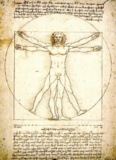
Leonardo da Vinci (Italian, 1452-1519), Study of proportions, from Vitruvius's
De Architectura, pen and
ink, 13 1/2 x 9 5/8 inches (34.3
x 24.5 cm), Accademia, Venice. See anatomy,
nude, Renaissance, and study.
Leonardo da Vinci, Skull, 1489. This is a lateral cross-section view of a human skull — the left half of the calvaria has been removed to expose the interior. See vanitas.
Leonardo da Vinci, Womb, or "The Foetus in Utero," 1489, red crayon and pen and ink, Collection of Queen Elizabeth II, Windsor Castle. Skull and Womb are among the huge number of anatomical drawings Leonardo made, to most of which he added written notes. He said he had dissected over thirty human bodies — men and women of various ages.
![]()
Leonardo da Vinci, The Christ Child with a Lamb [(recto),
with A Child with a Lamb, Head of an Old Man, and Studies
of Machinery (verso)], about 1503-1506, pen
and brown ink and black chalk, 8 1/4 x 5 9/16 inches (21 x 14.2 cm),
J. Paul Getty Museum, Malibu, CA.
Leonardo da Vinci, Head of a Young Woman, Accademia, Venice.

Leonardo da Vinci, Head of the Virgin, 1507-1513, charcoal,
black and red chalk;
traces of framing line in pen
and brown ink at upper right; repairs at right margin; lined;
8 x 6 1/8 inches (20.3 x 15.6 cm), Metropolitan Museum of Art,
NY.

Leonardo da Vinci, Virgin and Child with the Infant John the Baptist
and St. Anne, National Gallery, London, sketch
for the Madonna and Child with St. Anne and John the Baptist,
often identified as the Burlington House Cartoon. Leonardo's
later treatment of the same subject (without John the Baptist):
The Virgin and Child with Saint Anne,
1510, oil on wood,
5 1/2 x 4 1/2 feet (168 x 130 cm), Musée du Louvre, Paris.
See Madonna.
Ercole de' Roberti (Italian, Ferrara, c.1456-1496), Group Portrait: Members of the Este Family, pen, brown ink, 20.5 x 21 cm, Hermitage Museum, St. Petersburg, Russia. See Renaissance.
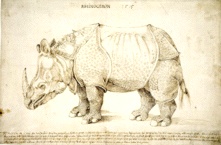
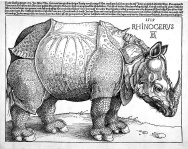
Albrecht Dürer (German, 1471-1528), The Rhinoceros, drawing and
woodcut, 1515, British Museum, London.
"Dürer produced this drawing and woodcut from reports of the arrival in Lisbon of an Indian rhinoceros in May of 1515. No rhinoceros had been seen in Europe for over 1000 years, so Dürer had to work solely from these reports. He covered the creature's legs with scales and the body with hard, patterned plates. Perhaps these features interpret lost sketches, or even the text, which states, '[The rhinoceros] has the color of a speckled tortoise and it is covered with thick scales'. So convincing was Dürer's fanciful creation that for the next 300 years European illustrators borrowed from his woodcut, even after they had seen living rhinoceroses without plates and scales." See Northern Renaissance and texture.
Albrecht Dürer, Portrait of Erasmus, 1520, black chalk, 14 3/5 x 10 1/2 inches (37.1 x 26.7 cm), Louvre.

Michelangelo Buonarroti (Italian, 1475-1564),
Sheet
of Studies for the Libyan Sibyl, 1508-12, red chalk (recto);
black chalk (verso); spots of brown wash at lower right of recto;
triangular section at right margin replaced, 11 3/8 x 8 7/16
inches (28.9 x 21.4 cm), Metropolitan Museum of Art, NY. Like
Raphael and Leonardo, Michelangelo typifies the concept of the
Renaissance
artist. Sculptor, painter,
architect,
draftsman, and poet, he
redefined the parameters
of each field through his own individual genius. Michelangelo
made these studies from a nude male model for the figure of the Libyan sibyl in the ceiling
frescoes of the Sistine Chapel, commissioned in 1508 and unveiled
in 1512. Here he studies the contours of the sibyl's twisting
back as she turns to close what will in the fresco become a large book on the ledge behind
her. Also on the sheet are sketches of the figure's profiled
head, hands,
and feet. Although drawn on the flat surface of a sheet of paper, Michelangelo's
figure has been drawn with the force and volume of a piece
of sculpture.
Through the motion of a body, the artist expresses the human
spirit. See study.
Michelangelo Buonarroti (Italian, 1475-1564), Deploration over the Dead Christ, c. 1530-1532/33, red chalk, 0.111 x 0.013 m, Louvre.

Raphael (Raffaello Sanzio) (Italian, 1483-1520),
Lucretia, pen and brown ink
over black chalk,
partially incised with
a stylus, 15 5/8 x 11
1/2 inches (39.7 x 29.2 cm), Metropolitan Museum of Art, NY.
Rosso Fiorentino (Giovanni Battista di Jacopo di Guasparre) (Italy, Florence, 1494-1540), Judith with the Head of Holofernes, c 1538-40, red chalk, 9 1/8 x 7 3/4 inches (23.2 x 19.7 cm), Los Angeles County Museum of Art.

Hans Holbein the Younger (German, 1497-1543),
Portrait of a Scholar or Cleric, about
1535, black and red chalk
and pen and brush and black ink on pink prepared paper,
8 5/8 x 7 1/4 inches (21.9 x 18.5 cm), J. Paul Getty Museum,
Malibu, CA. See Northern
Renaissance.
![]()
Attributed to Shaykh Muhammad (Persian, active
second half of 16th century), Weeping Man Drying His Eyes, third quarter
of 16th century, ink drawing on paper, signature
of Bihzad and date 892 A.H.
(1486 CE)
added later, Worcester Art Museum, MA. See Islamic art.
Turkey, c. 1575, Dragons Entwined On A Spray of Foliage, ink, color washes, and gold on paper, 7 1/8 x 3 3/4 inches (18.1 x 9.4 cm), Los Angeles County Museum of Art.
![]()
Turkish (Istanbul), Ottoman dynasty, Bayezid
I, "The Thunderbolt," Routs the Crusaders
at the Battle of Nicopolis, from the Hunernama
of Loqman, 1584, opaque
watercolor
and ink on paper, single page, Worcester Art Museum,
MA.

Jan Brueghel, the Elder (Flemish, 1568-1625),
View of Heidelberg, 1588-89, pen and
brown ink, brush and blue and brown washes,
heightened with white,
framing lines in pen and brown ink, 7 7/8 x 12 inches (20.0 x
30.5 cm), Metropolitan Museum of Art, NY.
![]()
India, Mughal dynasty, Performers and Animals at an Impromptu Circus
in the Countryside, c. 1590, drawing in brush, washes,
and color on paper;
Persian nastaliq calligraphy
on verso attributed to
Mir Ali, Worcester Art Museum, MA. See Mughal
dynasty.
Peter Paul Rubens (Flemish, 1577-1640), Portrait of the Daughter of Balthasar Gerbier d'Ouvilly, 1629, black, red and white chalk, with touches of pen with brown ink, on yellowish-grey paper, 33.5 x 23 cm, Hermitage Museum, St. Petersburg, Russia.

Matteo Rosselli (Italian, 1578-1650), Henri IV Entering Nantes,
1610, pen and brown ink, brown wash over black chalk and sanguine, 27.8 x 42.4 cm, Louvre.

Nicolas Poussin (French, 1594-1665), Bacchanal, c. 1635-6, pen and brown ink, brush
and brown wash, over faint
black chalk underdrawing,
5 1/4 x 8 1/8 inches (13.3 x 20.6 cm), Metropolitan Museum of
Art, NY.
![]()
Persian, Safavid dynasty, Flowering Plant beside a Pond, first
half of 17th century, silk: cut, voided satin, velvet, brocaded,
Worcester Art Museum, MA. See textile.
![]()
Pietro da Cortona (Italian, 1596-1669), Christ on the Cross with the Virgin Mary, Mary
Magdalene, and Saint John, about 1661, pen and brown
ink, with gray-brown wash,
heightened with white body color over black chalk, 15 7/8 x 10 7/16 inches (40.3 x 26.5
cm), J. Paul Getty Museum, Malibu, CA.
![]()
Rembrandt Harmensz. van Rijn (Dutch, 1606-1669),
Nude Woman with a Snake, about 1637,
red chalk heightened
with white body color,
9 11/16 x 5 7/16 inches (24.7 x 13.7 cm), J. Paul Getty Museum,
Malibu, CA.

Rembrandt Harmensz. van Rijn, Cottage among Trees, 1648-50, pen and
brown ink, brush and brown washes,
on paper washed
with brown, 6 3/4 x 10 7/8 inches (17.1 x 27.6 cm), vertical
strip 6 3/4 x 1 1/4 inches (17.2 x 3.2 cm) added by artist to
the sheet at right, Metropolitan Museum of Art, NY.
Rembrandt Harmensz. van Rijn, Landscape with a Horseman, 1656, pen, India ink, 16.8 x 23.4 cm, Hermitage Museum, St. Petersburg, Russia.
Rembrandt Harmensz. van Rijn, Two Studies of a Bird of Paradise, c. 1635-40, pen and sepia ink and wash, white highlights, 0.181 x 0.155 m, Louvre. See line and nature.
Job Berckheyde (Dutch, 1630-1693), Man Pulling a Rope, black and red chalk heightened with sanguine, 9 3/4 x 6 3/4 inches (24.6 x 17 cm), Michael C. Carlos Museum, Emory U, Atlanta, GA.
Jean-Antoine Watteau (French, 1684-1721), Two Studies of a Flutist and a Study of the Head of a Boy, about 1716-1719, red, black, and white chalk on buff-colored paper, 8 7/16 x 13 3/16 inches (21.4 x 33.6 cm), J. Paul Getty Museum, Malibu, CA. See Baroque, Rococo, and trois crayons.

Antoine Watteau, Head of a Man, c. 1718, red and black
chalk, 5 7/8 x 5
3/16 inches (14.9 x 13.1 cm), Metropolitan Museum of Art, NY.
Francesco Guardi (Italian, 1712-1793), Triumphal Arch on the Embankment, Venice, pen and brown ink with brown wash, watercolor, heightened with white, 28 x 19.1 cm, Hermitage Museum, St. Petersburg, Russia.

Giovanni Battista Piranesi (Italian, 1720-1778),
An Ancient Port, 1749-1750, red and black
chalk and brown
and reddish wash, squared
in black chalk,
15 1/8 x 20 13/16 inches (38.5 x 52.8 cm), J. Paul Getty Museum,
Malibu, CA.
![]()
Thomas Gainsborough (English, 1727-1788),
London, A Lady Walking in a Garden with a Child,
about 1785, black chalk
with stumping on light
brown paper, heightened
with white pastel,
20 x 8 11/16 inches (50.5 x 22.1 cm), J. Paul Getty Museum, Malibu,
CA.
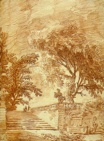
Hubert Robert (France, 1733-1808), Landscape
with Steps, 1770s, red chalk,
17 1/2 x 12 5/8 inches (44.5 x 32.1 cm), Los Angeles County Museum
of Art.

Henry Fuseli (English, born Switzerland,
1741-1825), Self-Portrait as a Faun [verso:
Head of a Woman Three-Quarters to Left ], pencil
and chalk on paper, 32.2 x 42.7 cm, Tate Gallery,
London. See Romanticism
and self-portrait.
Caspar David Friedrich (German, 1774-1840), Moonrise, 1835-1837, sepia wash over a pencil sketch, bordered with India ink, 24.5 x 34.5 cm, Hermitage Museum, St. Petersburg, Russia. See Romanticism.

Joseph Mallord William Turner (English, 1775-1851),
Conway Castle, North Wales, 1798, watercolor and gum
arabic with graphite
underdrawing, 21 1/8 inches
x 30 1/8 inches (53.6 x 76.7 cm), J. Paul Getty Museum, Malibu,
CA.
Jean-Auguste-Dominique Ingres (French, 1780-1867), Studies of Female Nudes, charcoal and black crayon, 0.620 x 0.450 m, Louvre. See nude and study.

Honoré-Victorin Daumier (French, 1808-1879),
The Connoisseur, c. 1860-65, pen and
ink, wash,
watercolor, lithographic
crayon, and gouache over black chalk, wove
paper; sheet: 17 1/4 x 14 inches (43.8 x 35.5cm), Metropolitan
Museum of Art, NY. See connoisseur.
Gustave Courbet (French, 1819-1877), Portrait of Juliette Courbet as a Sleeping Child, 1841, graphite on paper, Musée d'Orsay. See Realism.

Hilaire Germain Edgar Degas (French, 1834-1917),
Self-Portrait, about 1857-1858, oil
on paper,
laid down on canvas, 8
1/8 x 6 1/2 inches (20.6 x 15.9 cm), J. Paul Getty Museum, Malibu,
CA. See Impressionism
and self-portrait.

Edgar Degas, Édouard Manet, Seated, 1866-68,
portrait
of Édouard Manet (French, 1832-1883), black chalk on off-white wove paper; sheet: 13 1/16 x 9 1/16 inches
(33.1 x 23 cm), Metropolitan Museum of Art, NY.

Paul Cézanne (French, 1839-1906),
Still Life, about 1900, watercolor
and graphite, 18 15/16
x 24 7/8 inches (48 x 63.1 cm), J. Paul Getty Museum, Malibu,
CA. See still
life and Post-Impressionism.
Edwin Austin Abbey (American, 1852-1911), Harvest Home, 1887, pen and ink on paperboard, sheet: 21 x 14 1/4 inches (53.3 x 36.2 cm), National Museum of American Art.

Vincent van Gogh (Dutch, 1853-1891), Road in Etten, 1881, chalk, pencil,
pastel, watercolor,
15 1/2 x 22 3/4 inches (39.4 x 57.8 cm), Metropolitan Museum
of Art, NY.

Vincent van Gogh, Portrait of Joseph Roulin, 1888, reed
quill pens and brown ink and black
chalk, 12 5/8 x
9 5/8 inches (32 x 24.4 cm), J. Paul Getty Museum, Malibu, CA.
Vincent van Gogh, Tree with Ivy in the Asylum Garden, May 1889 (Saint-Rémy), pencil, chalk, reed pen, and brown ink on Ingres paper, 24 x 18 1/4 inches (61 x 47 cm), Rijksmuseum Vincent Van Gogh, Amsterdam, F 1532. Also see Post-Impressionism.
Vincent van Gogh, Wheat Field with Sun and Cloud, May 1889 (Saint-Rémy), black chalk, reed pen and brown ink, heightened with white chalk, on Ingres paper, 18 3/4 x 22 inches (47.5 x 56 cm), Rijksmuseum Kroller-Muller, Otterlo, F 1728.
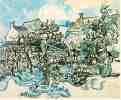
Vincent van Gogh, Old Vineyard with Peasant Woman, end
of May 1890 (Auvers-sur-Oise), pencil,
brush, watercolor,
and gouache, 17
1/4 x 21 1/4 inches (43.5 x 54 cm), Rijksmuseum Vincent van Gogh,
Amsterdam, F 1624.

Henri-Edmond Cross (French, 1856-1910), Landscape with Stars, watercolor
over pencil on paper,
9 5/8 x 12 5/8 inches (20.5 x 32.5 cm), Metropolitan Museum of
Art, NY. See landscape
and Neo-Impressionism.
Paul Klee (German, 1879-1940), Birds Making Scientific Experiments in Sex, pen and black ink, signed and dated 1915 and numbered 28 on the mount, 7 6/16 x 4 5/8 inches (18.8 x 11.9 cm), Michael C. Carlos Museum. Also see Bauhaus and Swiss art.
Pablo Picasso (Spanish, 1881-1973), Boy with a Dog, 1905, gouache on cardboard, 57 x 41 cm, Hermitage Museum, St. Petersburg, Russia.

Robert Minor (American, 1884-1952), Pittsburgh,
1916, lithographic
crayon and India
ink, published in The Masses, no. 8, August 1916.
Robert Minor produced this drawing as an editorial cartoon, commenting on a 1916 steel
workers' strike. He was among the first American editorial cartoonists
to employ crayon and ink brush, when most were using pen and
ink. Minor drew inspiration for this approach from such European
masters as Francisco Goya and Honoré Daumier, coming to
produce such spare, forceful drawings as this. See emphasis,
movement,
and social realism.

Maurits Cornelis Escher (Dutch, 1898-1972),
Drawing Hands, 1948, lithograph. See optical
illusion.
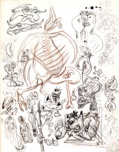
Jackson Pollock (American, 1912-1956), Untitled (Number 37), about 1939-40, pen and brown and black ink, graphite, and orange colored pencil on smooth coated paper, Hood Museum of Art, Dartmouth College, NH.

Robert Smithson (American, 1938-1973), Spirals, no date, c. 1970, graphite
drawing on paper, 9 x 12 inches. See earth art, landscape, and volute.
Also see abbozzo, bin, brush, ink, chalk, charcoal, comparison, computer graphics, conté crayon, crayon, cross-section, diagram, elevation, épure, exhibit, feather, freehand, fusain, hatching, interdisciplinary, mechanical drawing, pastel, pen, pencil, plan, portfolio, quotations, sinopia, wash, and watercolor.
https://inform.quest/_art
Copyright © 1996-![]()